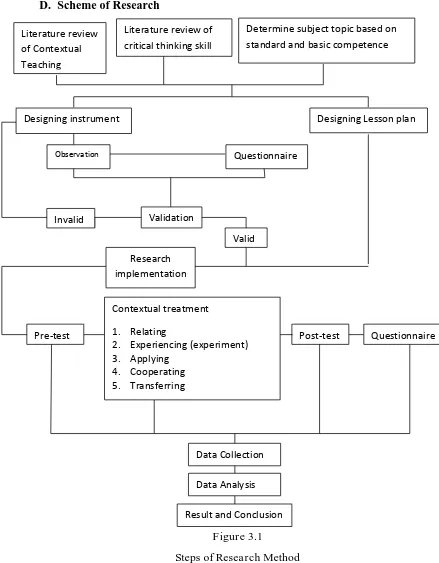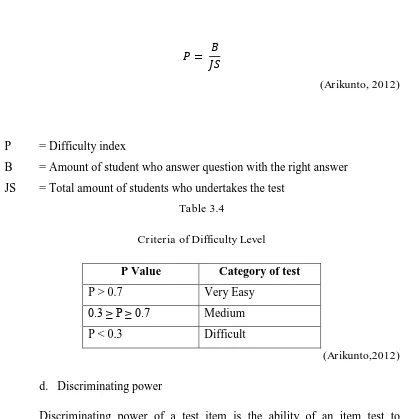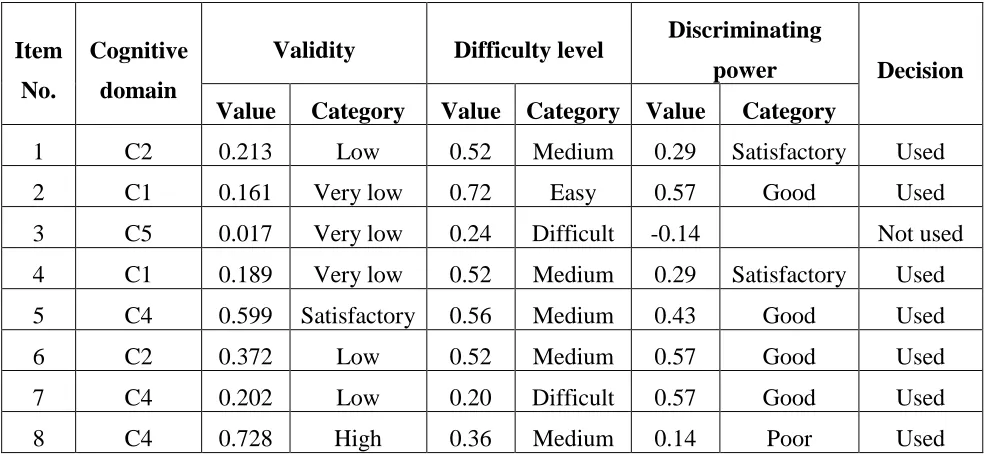Afif Naofal Pramana, 2014
Contextual Teaching Learning to Improve Students’ Critical Thinking Skill and Concept Comprehension in Changes of Matter Topic for Junior High School
Universitas Pendidikan Indonesia | repository.upi.edu | perpustakaan.upi.edu
CHAPTER III
RESEARCH METHODOLOGY
A. Location and Subject
This research is implemented in one of International School in Bandung which applied KTSP in the learning process. The subjects of this research are 15 students in secondary 1(grade 7). The sampling method that is carried out is availability sampling method where the selection of subject with this method is not regarding to the aspect of strata, random or region, but subjects are selected based on its availability. In fact, this form of sampling is the most common type in educational research since probability samples, particularly in experimental studies, are maybe impossible (McMillan and Schumacher, 2001).
B. Research Design
Method that is used in this research is weak-experimental with one class pre-test post-test design. Because the number of classes that given treatment is only one class in the absence of control class. In this design, observations are done before and after treatment given. Observations were conducted before the treatment is given is called the pre-test, whereas the observations made after the treatment given is called the post-test.
Table 3.1
Pre-test and post-test design
Pretest Treatment Post test
O1 X O1
Afif Naofal Pramana, 2014
Contextual Teaching Learning to Improve Students’ Critical Thinking Skill and Concept Comprehension in Changes of Matter Topic for Junior High School
Universitas Pendidikan Indonesia | repository.upi.edu | perpustakaan.upi.edu
With:
O1 = Pre-test before treatment is given O2 = Post-test after treatment is given X = Instruction with Contextual Teaching
C. Research Method
Afif Naofal Pramana, 2014
Contextual Teaching Learning to Improve Students’ Critical Thinking Skill and Concept Comprehension in Changes of Matter Topic for Junior High School
Universitas Pendidikan Indonesia | repository.upi.edu | perpustakaan.upi.edu
D. Scheme of Research
Figure 3.1
Steps of Research Method
Determine subject topic based on standard and basic competence Literature review of
critical thinking skill
Designing instrument Designing Lesson plan
Afif Naofal Pramana, 2014
Contextual Teaching Learning to Improve Students’ Critical Thinking Skill and Concept Comprehension in Changes of Matter Topic for Junior High School
Universitas Pendidikan Indonesia | repository.upi.edu | perpustakaan.upi.edu
E. Operational Definition
1. Contextual Teaching Learning
Contextual Teaching Learning is an educational process that aims to help students see meaning in the academic material they are studying by connecting academic subjects with the context of their personal, social, and cultural circumstances. To achieve this aim, the system encompasses the following eight components: making meaningful connections, doing significant work, self- regulated learning, collaborating, critical and creative thinking, nurturing the individual, reaching high standards, and using authentic assessments (Sitinjak, 2002).
In this research contextual teaching learning is used as an approach which carried out by giving students a problem that relating with surrounding and asking students to make product or opinion to solve the problem.
2. Critical Thinking Skill
Critical thinking skill is critical thinking as a permitted of individual to do these cases: exactly know main issue and supposing plan to find the connection of issues and make inferential and appropriate formula better than announce the data, and then give interpretation a conclusion with data (Pascarella and Terenzini, 2005).
The critical thinking that by using critical criteria include of was identified and formulated criteria of possibility answer, identify conclusion, use procedure, ability to give reason, hypothesis, concept application, and consider of alternative solutions. The data of critical thinking was gained by students’ objective test.
3. Changes of Matter Concept Comprehension
post-Afif Naofal Pramana, 2014
Contextual Teaching Learning to Improve Students’ Critical Thinking Skill and Concept Comprehension in Changes of Matter Topic for Junior High School
Universitas Pendidikan Indonesia | repository.upi.edu | perpustakaan.upi.edu
test score that will be interpreted into category of improvement according to Hake (1998).
F. Instructional Materials
The instructional materials that will be used in this research includes lesson plan, learning scenario, instructional tools, media and sources. The lesson plan is made according to the Scheme of Work (SOW) of Secondary 1 Science used in school which is derived from the Cambridge Combined Science Syllabus 2012. The learning scenario is then constructed according to the weekly lesson plan that has been made. The learning scenario itself is made to make the planning of the lesson is more specific and detailed.
In an instruction tools, media and sources are essential. By the presence of those three, the instruction can be made more effective in achieving the desired objectives. The instructional tools that are used in the implementation of Contextual Teaching are projector, laptop and board. The Medias that will be used are power point slides and students’ worksheet.
G. Instruments
The research instruments which are designed and used in this study are in the form of tests and non-test. Associated with the data needed, the test instrument to be used consists of achievement test, while non-test instrument to be used consists of observation sheet towards students’ learning activities that cannot be observed by observation, observation sheets for Contextual Teaching such as:
1. Test
A test is commonly defined as a tool or instrument of measurement that is
used to obtain data about a specific trait or characteristic of an individual or group.
Afif Naofal Pramana, 2014
Contextual Teaching Learning to Improve Students’ Critical Thinking Skill and Concept Comprehension in Changes of Matter Topic for Junior High School
Universitas Pendidikan Indonesia | repository.upi.edu | perpustakaan.upi.edu
2. Non Test
In this research, non-test instrument that will be used is in form of observation sheets as follow:
a. Observation sheet towards Contextual Teaching implementation
Use the observation sheet to measure implementation of teacher and the activity levels and criticality of students in the learning process as the objects. Observation sheet contains the learning stage which is used to view the activities teacher and students.
b. Questionnaire of students’ response toward the implementation of Contextual Teaching Learning.
This instrument will be used to record the students’ response toward the implementation of Science Technology Society. Students are required to choose one of five scale (strongly disagree, disagree, undecided, agree and strongly agree) for each statement
H. Instrument Development Process Analysis of Test Instrument
Before being used in research, test instrument need to be judged and tried first. The result from the trial will then be analyzed based on its validity, reliability, difficulty level, and discriminating power.
a. Validity
Afif Naofal Pramana, 2014
Contextual Teaching Learning to Improve Students’ Critical Thinking Skill and Concept Comprehension in Changes of Matter Topic for Junior High School
Universitas Pendidikan Indonesia | repository.upi.edu | perpustakaan.upi.edu
To measure the validity of each test, using the Coefficient of Product Moment Karl Pearson, there is:
∑ [ ∑ ∑ ]
√[ ∑ ∑ ][ ∑ ∑ ]
With,
: Correlation coefficient between x and y variable
n : Amount of student
Instruments are validating by the expert then trial test measure realibility, difficulty index, and discriminating power was conducted.
b. Reliability
Afif Naofal Pramana, 2014
Contextual Teaching Learning to Improve Students’ Critical Thinking Skill and Concept Comprehension in Changes of Matter Topic for Junior High School
Universitas Pendidikan Indonesia | repository.upi.edu | perpustakaan.upi.edu
measure the degree of target consistently measured. Reliability is expressed as a number, usually as a coefficient. High coefficient means high reliability. it can be concluded that reliability is a constancy of a test to measure or observe something that is the object of measurement.
The reliability coefficient can be obtained by using K-R 20 formula in Sugiyono (2008). The value is then interpreted according to its criteria.
( ) ∑
(Arikunto,2012) r11 = Instrument reliability
k = Amount of test item
∑pq = Multiplication result of p and q s = Deviation standard
Table 3.3
Reliability Value
Reliability coefficient Criteria
0.00 < x ≤ 0.20 Very low
0.20 < x ≤ 0.40 Low
0.40 < x ≤ 0.60 Satisfactory
0.60 < x ≤ 0.80 High
0.80 < x ≤ 1.00 Very high
(Arikunto,2012)
c. Difficulty level
Afif Naofal Pramana, 2014
Contextual Teaching Learning to Improve Students’ Critical Thinking Skill and Concept Comprehension in Changes of Matter Topic for Junior High School
Universitas Pendidikan Indonesia | repository.upi.edu | perpustakaan.upi.edu
(Arikunto, 2012)
P = Difficulty index
B = Amount of student who answer question with the right answer JS = Total amount of students who undertakes the test
Table 3.4
Criteria of Difficulty Level
P Value Category of test
P > 0.7 Very Easy
0.3 ≥ P ≥ 0.7 Medium
P < 0.3 Difficult
(Arikunto,2012)
d. Discriminating power
Discriminating power of a test item is the ability of an item test to differentiate high achiever students with low achiever students. The value that shows differentiating power is called discrimination index. This index is in between 0.00 until 1.00. The value which is obtain is interpreted according to discriminating power criteria in Arikunto (2012)
(Arikunto, 2012)
D = Discriminating power JA = Amount of high achiever
JB = Amount of low achiever
Afif Naofal Pramana, 2014
Contextual Teaching Learning to Improve Students’ Critical Thinking Skill and Concept Comprehension in Changes of Matter Topic for Junior High School
Universitas Pendidikan Indonesia | repository.upi.edu | perpustakaan.upi.edu
BB = Amount of low achiever who answers question with the right answer
PA = Proportion of high achiever who answers question with the right answer
PB = Proportion of low achiever who answers question with the right answer
Table 3.5
Criteria of Test Item Discriminating Power
Discriminating power interval
Criteria of discriminating power
Negative Test item is not
appropriate
0.00 < x ≤ 0.20 Poor
0.21 < x ≤ 0.40 Satisfactory
0.41 < x ≤ 0.70 Good
0.71 < x ≤ 1.00 Excellent
(Arikunto, 2012)
Table 3.6
Recapitulation of Validity Test Item in Concept Comprehension
Item No.
Cognitive domain
Validity Difficulty level Discriminating
power Decision Value Category Value Category Value Category
Afif Naofal Pramana, 2014
Contextual Teaching Learning to Improve Students’ Critical Thinking Skill and Concept Comprehension in Changes of Matter Topic for Junior High School
Universitas Pendidikan Indonesia | repository.upi.edu | perpustakaan.upi.edu
9 C1 0.174 Very low 0.72 Easy 0.57 Good Used
10 C5 0.293 Low 0.40 Medium 0.29 Satisfactory Used
11 C2 0.126 Very low 0.36 Medium 0.43 Good Used
12 C2 0.334 Low 0.52 Medium 0.57 Good Used
13 C4 0.425 Satisfactory 0.44 Medium 0.57 Good Used
14 C3 0.653 High 0.60 Medium 0.57 Good Used
15 C2 0.168 Very low 0.44 Medium 0.29 Satisfactory Used 16 C3 0.471 Satisfactory 0.56 Medium 0.29 Satisfactory Used
17 C2 0.222 Low 0.36 Medium 0.14 Poor Used
18 C1 0.416 Satisfactory 0.40 Medium 0.14 Poor Used
19 C5 0.010 Very low 0.28 Difficult -0.14 Not used
20 C4 0.190 Very low 0.36 Medium 0.14 Poor Used
e. Observation sheet analysis
In this research, there are observation sheets toward students’ learning activities, observation sheets toward learning interaction pattern and observations sheets toward the implementation of Contextual Teaching. These instruments are evaluated by supervisor first and judged by lecturer before it is used in the research.
Table 3.7
Observation Sheet to Measure Students’ Critical Thinking
Indicator No Criteria Checklist
Definition and classification of
problem
1 Identify problem
Afif Naofal Pramana, 2014
Contextual Teaching Learning to Improve Students’ Critical Thinking Skill and Concept Comprehension in Changes of Matter Topic for Junior High School
Universitas Pendidikan Indonesia | repository.upi.edu | perpustakaan.upi.edu Assess information
related to the problem
1 Find causes of problem
2 Assess impact of problem
3 Predict the effects of further
Designing solution
based on problem 1 Design solution based on problem
f. Questionnaire analysis
In this research, the questionnaire will be used to measure students’ response toward working as a team, toward games in science and toward reading infusion. The questionnaire is evaluated by supervisor and judged by lecturer before it is used in the research. Questionnaire is given to students to give the checklist sign according of statements.
Table 3.8
Students opinion towards critical thinking 16, 17, 18, 19, and 20 .
I. Data Analysis Technique
1. Data analysis on students concept comprehension
Afif Naofal Pramana, 2014
Contextual Teaching Learning to Improve Students’ Critical Thinking Skill and Concept Comprehension in Changes of Matter Topic for Junior High School
Universitas Pendidikan Indonesia | repository.upi.edu | perpustakaan.upi.edu
Table 3.9
Category scale of students’ understanding
Score Category
S ≤ 20 Very poor
21 ≤ S ≤ 40 Poor
41 ≤ S ≤ 60 Satisfactory
61 ≤ S ≤ 80 Good
81 ≤ S ≤ 100 Excellent
Gain score of the students was obtained from the differences between pre-test and post-pre-test as the effect of the intervention. This calculation of gain is to determine the students’ achievement improvement by using this formula:
(Hake,1998)
G = Gain
= Post-test score
= Pre-test score
The effectiveness Contextual Teaching in increasing students’ achievement of concept comprehension in states of matter will be seen from the result of the normalized gain that achieved by students during the learning processas follows:
(Hake, 1999)
< g> = Normalized gain G = Actual gain
Afif Naofal Pramana, 2014
Contextual Teaching Learning to Improve Students’ Critical Thinking Skill and Concept Comprehension in Changes of Matter Topic for Junior High School
Universitas Pendidikan Indonesia | repository.upi.edu | perpustakaan.upi.edu
Sf = Post-test score
Si = Pretest score
Then, the value of <g> is determined based on criteria below: Table 4.10 gained from values that obtained by students, which are divided by the number of students in the class in order to obtain the average test which can be formulated:
∑
Then the final result can be compared between pretest and posttest.
4. The implementation of Contextual Teaching to measure the students’ critical thinking
To measure students’ critical thinking in this research is used an observational sheet. The fulfillment of the observational sheet is given the check list mark on the available coloum that representative of appereance of students’ activity based on the indicator. The observer will observe students appereance of critical and guided by observational sheet. Data obtained from observational sheet using percentage by this formula:
Afif Naofal Pramana, 2014
Contextual Teaching Learning to Improve Students’ Critical Thinking Skill and Concept Comprehension in Changes of Matter Topic for Junior High School
Universitas Pendidikan Indonesia | repository.upi.edu | perpustakaan.upi.edu
R = Actual response observed Rmax = Maximum possible response
Table 4.11
Percentage of lesson implementation
Percentage Category
80% or more Very Good
60%-79% Good
40%-59% Satisfactory
21%-39% Poor
0%-20% Very Poor
(Arikunto, 2010)
5. Data processing in questionnaire
Contextual Teaching is an approach to enhance critical of students. This treatment measured by questionnaire, there will be 20 questions with 2 optional answers. The fulfillment of the questionnaire is given check list mark on the available coloum that representative of yes and no.
Data obtained from the questionnaire using percentages by formula below:
(Arikunto,2010) P = Response percentage
R = Actual response observed Rmax = Maximum possible response
Percentage of students responses were interpreted using a qualitative interpretation of the questionnaire below:
Table 4.12
Afif Naofal Pramana, 2014
Contextual Teaching Learning to Improve Students’ Critical Thinking Skill and Concept Comprehension in Changes of Matter Topic for Junior High School
Universitas Pendidikan Indonesia | repository.upi.edu | perpustakaan.upi.edu
Percentage Interpretation
4. Correlation a regression between students’ critical thinking and concept comprehension.
Correlation analysis was perfomed to find the value of r or it called by correlation coeficient. Correlation analysis can be seen by using IBM SPSS 20. Correlation analysis can be interpreted in some category in this table below:
Table 4.13 formula shown in table below:
(Arikunto,2010) R = Coefficint determination
r = correlation
Afif Naofal Pramana, 2014
Contextual Teaching Learning to Improve Students’ Critical Thinking Skill and Concept Comprehension in Changes of Matter Topic for Junior High School
Universitas Pendidikan Indonesia | repository.upi.edu | perpustakaan.upi.edu
There are three phases of research procedure in this research, such as: 1. Preparation
In this phase is the first what the researcher will do. This is also important because it will make the purpose of the paper. Researcher may focus on problem, searching information and then design the new method that researcher want to improve weakness from the problem. This is the procedure determine by steps:
a. Determining teaching material that will be used in this research. b. Designing teaching learning.
c. Making research instrument. d. Instrument Validation. e. Revising instrument. f. Preparing research license. g. Determining research subject
2. Implementation
This implementation phase is the action of design that researcher did. Design given to students such as solves of the problem. So there is a treatment in the experimental class such as construct the students’ concept to make their respect to the real life of that problem (actually for all the subjects) which about states of matter. In the class must do pre-test and then in the end post-test. In this stage researcher will analyse the differences of pre-test and post-test.
3. Analysis
Afif Naofal Pramana, 2014
Contextual Teaching Learning to Improve Students’ Critical Thinking Skill and Concept Comprehension in Changes of Matter Topic for Junior High School








